6 Best Cable Back Exercises (with Pictures!)
If there is one thing the cable machine does well, it is back exercises. The constant time under tension and highly variable angle of resistance allow for quite a number of back exercises to be effective.
Although more common exercises like the cable row or lat pulldown are a few good examples, some lesser known cable exercises are unfortunately underutilized by many lifters.
In this article, we’ve elected to list the most popular - and most effective - cable back exercises out there, with brief explainers on their benefits and how to perform them safely.
What are Cable Back Exercises - and What Benefits do They Offer?
Simply put, cable back exercises are pulling exercises performed with the use of a cable pulley machine.
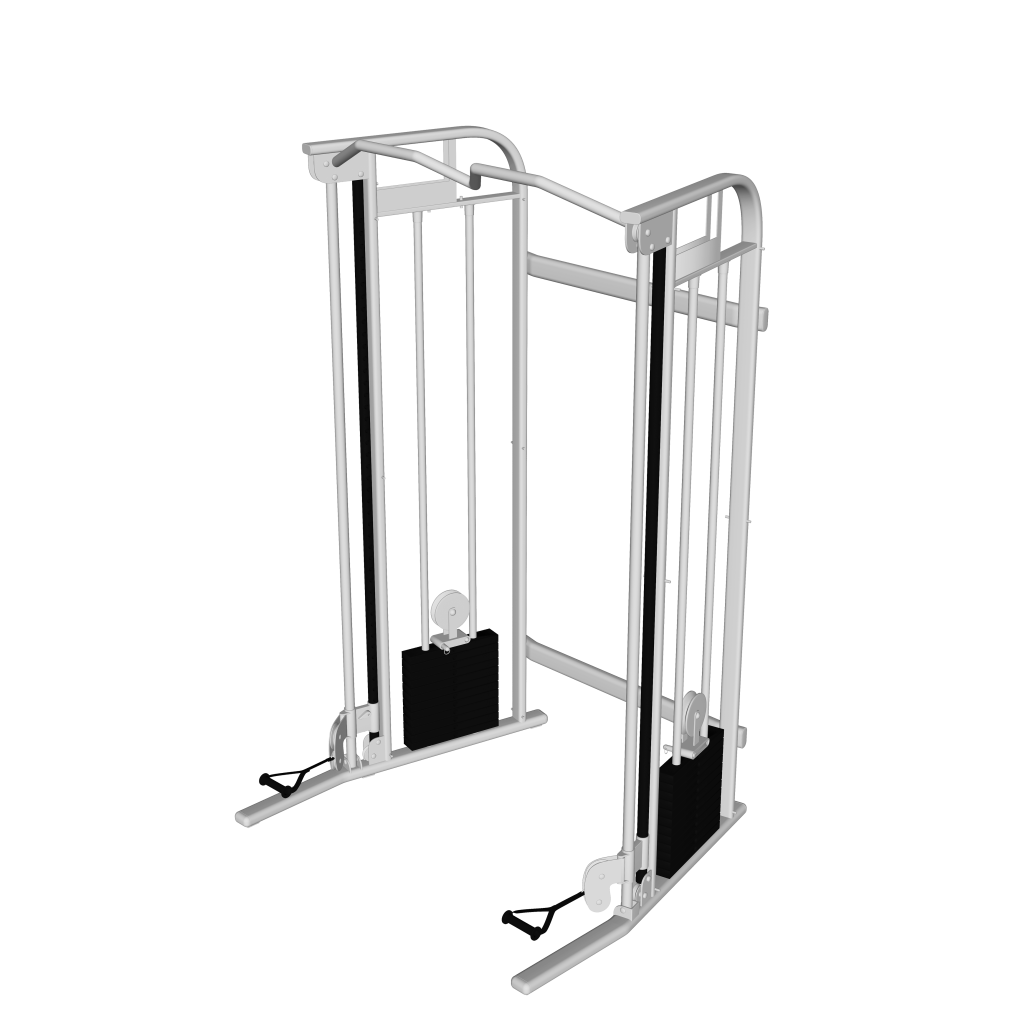
While they vary in terms of muscular recruitment and movement pattern, they all share a similar goal; to develop the muscles of the back and biceps.
Cable back exercises are of particular note for being low-risk and easy to perform for high volume. They are the ideal starting exercise for novice weightlifters, or for bodybuilders looking to maximize hypertrophy in their workouts.
General Benefits of Cable Back Exercises
Apart from being safer than free weights and more volume-friendly, cable-based back exercises benefit from the adjustability of the cable machine itself.
While most free weight or calisthenics back exercises feature a vertical angle of resistance due to gravity, cable machines are not limited in the same scope. This allows individuals to perform exercises that are otherwise impossible with other types of resistance equipment.
In addition, the constant time under tension provided by the machine allows for a greater quality of each repetition.
Best Cable Back Exercises
1. Cable Rows
The most obvious example of a cable back exercise is the cable row; a compound horizontal pull that targets the entirety of the back in a highly intense manner.
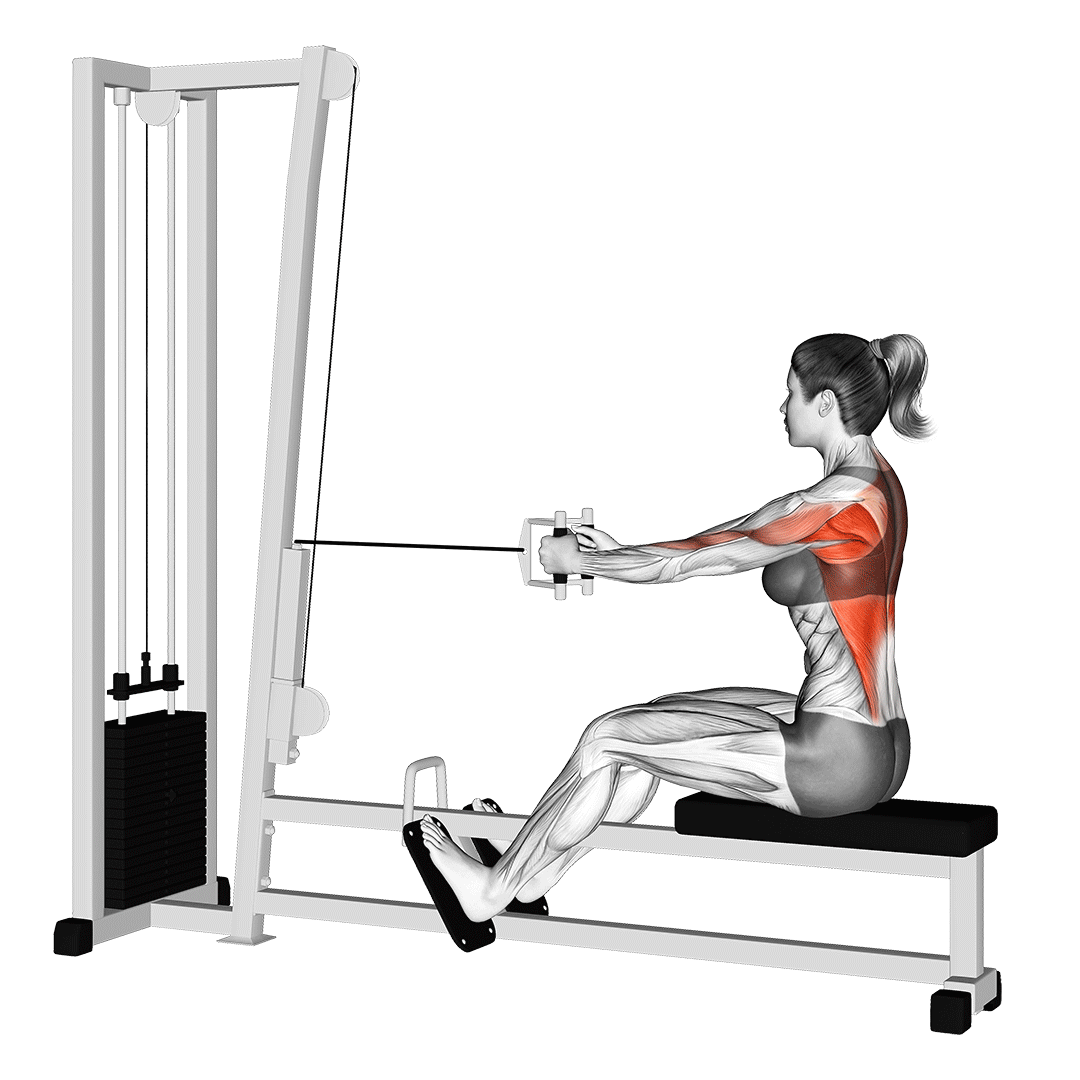
Cable rows are often favored by bodybuilders for their capacity to develop the thickness of the back, as well as their high capacity for volume.
If so desired, the grip style, width and even the tilt of the body can all be altered so as to emphasize different parts of the body - all of which are also considered variations of the standard cable row.
Another important distinction to make is the difference between seated and standing cable rows. For the purposes of brevity, we will focus on the more common seated variation.
Muscles Worked
Cable rows target the latissimus dorsi, trapezius, biceps, posterior deltoid head and other muscles found within the mid-back.
Benefits as a Cable Back Exercise
Apart from being one of the most comprehensive back exercises possible on a cable machine, the cable row is also one of the heaviest in terms of gross weight moved. This makes it excellent as a tool for building not only thickness in the back, but also strength.
In addition, as previously mentioned, cable rows can be modified to suit the lifter’s needs.
By switching to a one-handed attachment, the exercise may be made unilateral. Likewise, greater attention to the lower trapezius, teres and infraspinatus can be achieved by using a close grip handle - with the reverse being true for emphasizing the lats.
How-to:
To perform a repetition of the conventional cable row, the lifter will seat themselves facing the machine’s stack, affixing a two-handed attachment to the cable.
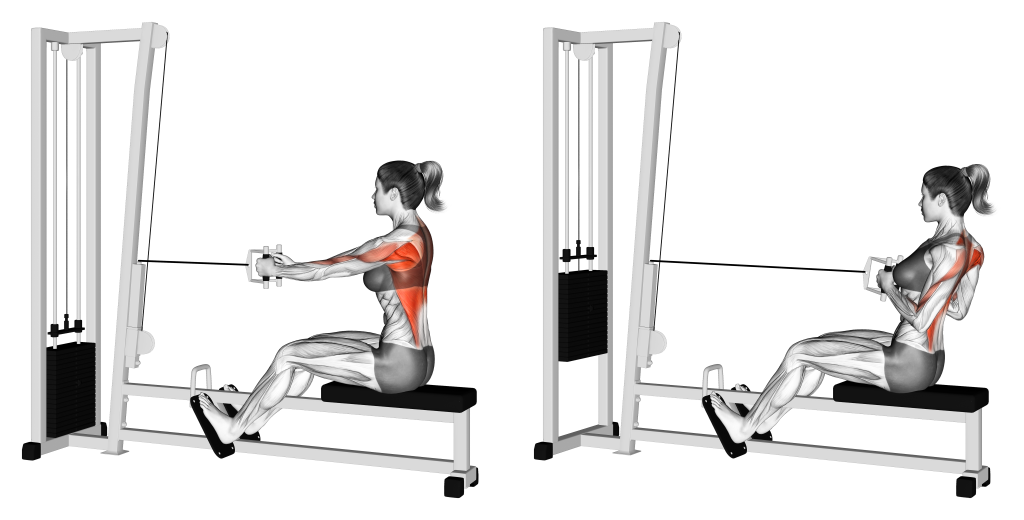
Planting their feet on the footpads if available, the lifter will then draw their torso backwards, keeping the handle gripped at arms-length as they do so.
Once the torso is upright and the chest pushed forwards, the lifter will pull their elbows towards the rear of their body, squeezing their lats as they do so.
When the elbows are parallel to the sides of the torso and the handle is nearly touching the sternum, the lifter will slowly reverse the motion and extend their arms back out - thereby completing the repetition.
2. Lat Pulldowns
The second most common form of cable back exercise is the lat pulldown.
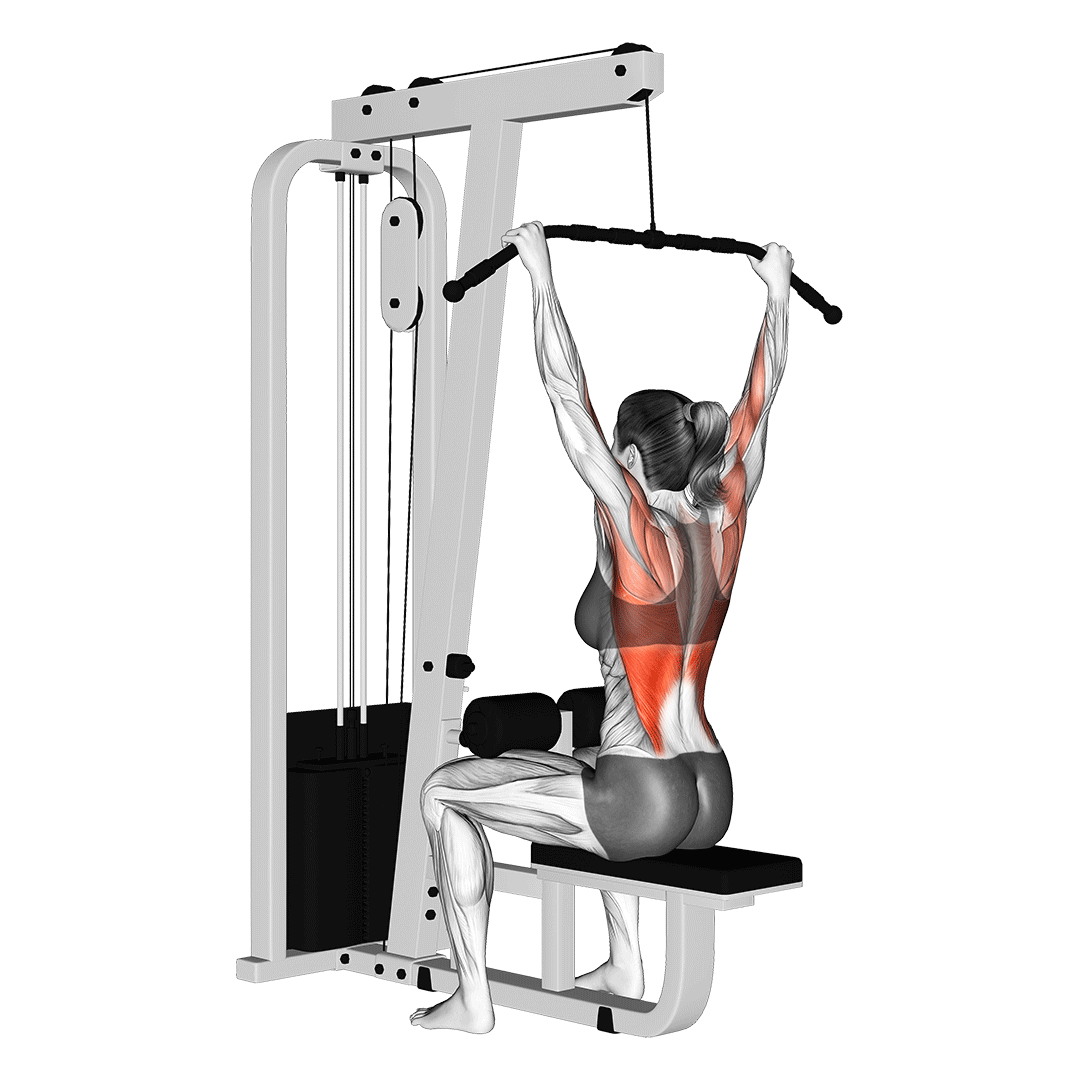
Lat pulldowns are essentially a less intense and more adjustable form of a standard pull-up, as they involve a vertical pulling motion and target much the same muscle groups in the upper body.
The lat pulldown is frequently used to build width and vertical pulling strength in the back, and is often programmed as an accessory movement to heavier back exercises.
Muscles Worked
As their name implies, lat pulldowns primarily target the latissimus dorsi.
However, they will also recruit the biceps brachii, the posterior head of the deltoids, the rhomboids, the teres muscles and the trapezius to a lesser extent.
Benefits as a Cable Back Exercise
Lat pulldowns are among one of the best exercises for targeting the lats - not only among cable exercises, but back exercises as a whole. The fact that they work the lats through a large range of motion only adds to that, as the lat pulldown can easily be geared towards high resistance or high volume as needed.
How-to:
To perform a repetition of the lat pulldown, the lifter will seat themselves within the lat pulldown machine, gripping the bar in a double overhand grip. If using a standard cable machine instead, the exercise may be performed kneeling or with the addition of a bench.
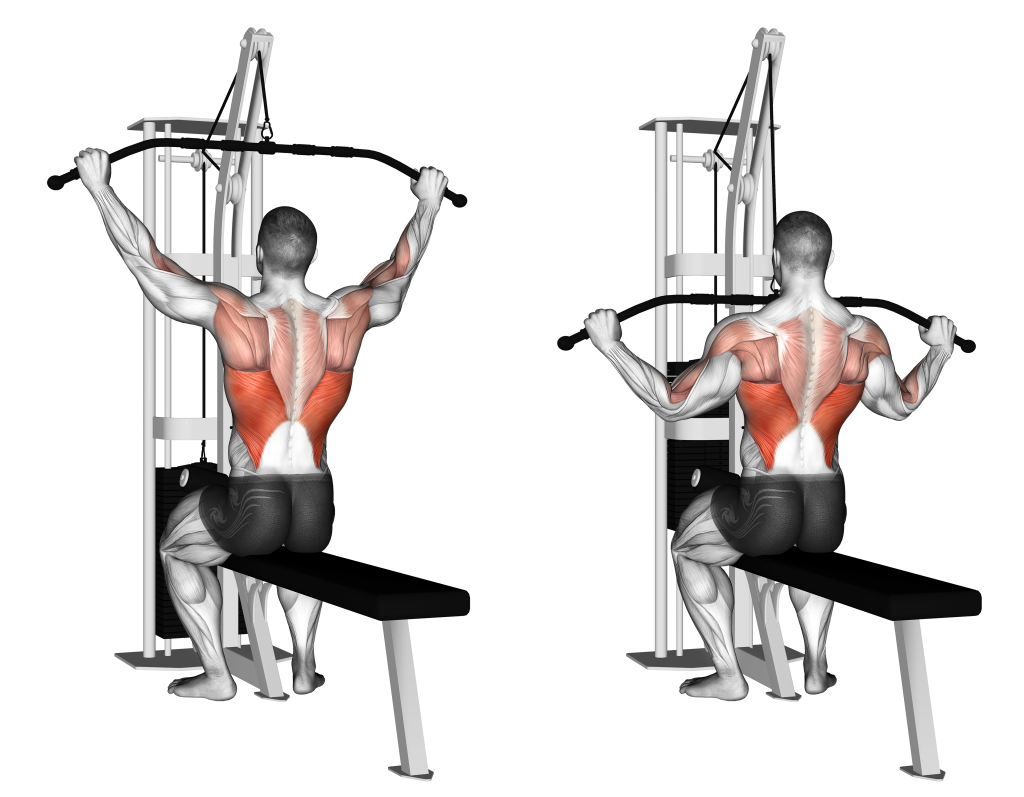
Once positioned to begin, the lifter will tilt their torso slightly backwards as they pull their elbows both downwards and backwards. As their elbows retract, so too will the shoulder blades, squeezing together until the bar is beneath the lifter’s chin.
From this point, the lifter will simply reverse the motion in a slow and careful manner - thereby completing the repetition.
3. Cable Shrugs
For a more comprehensive trapezius workout, try including cable shrugs into your program.
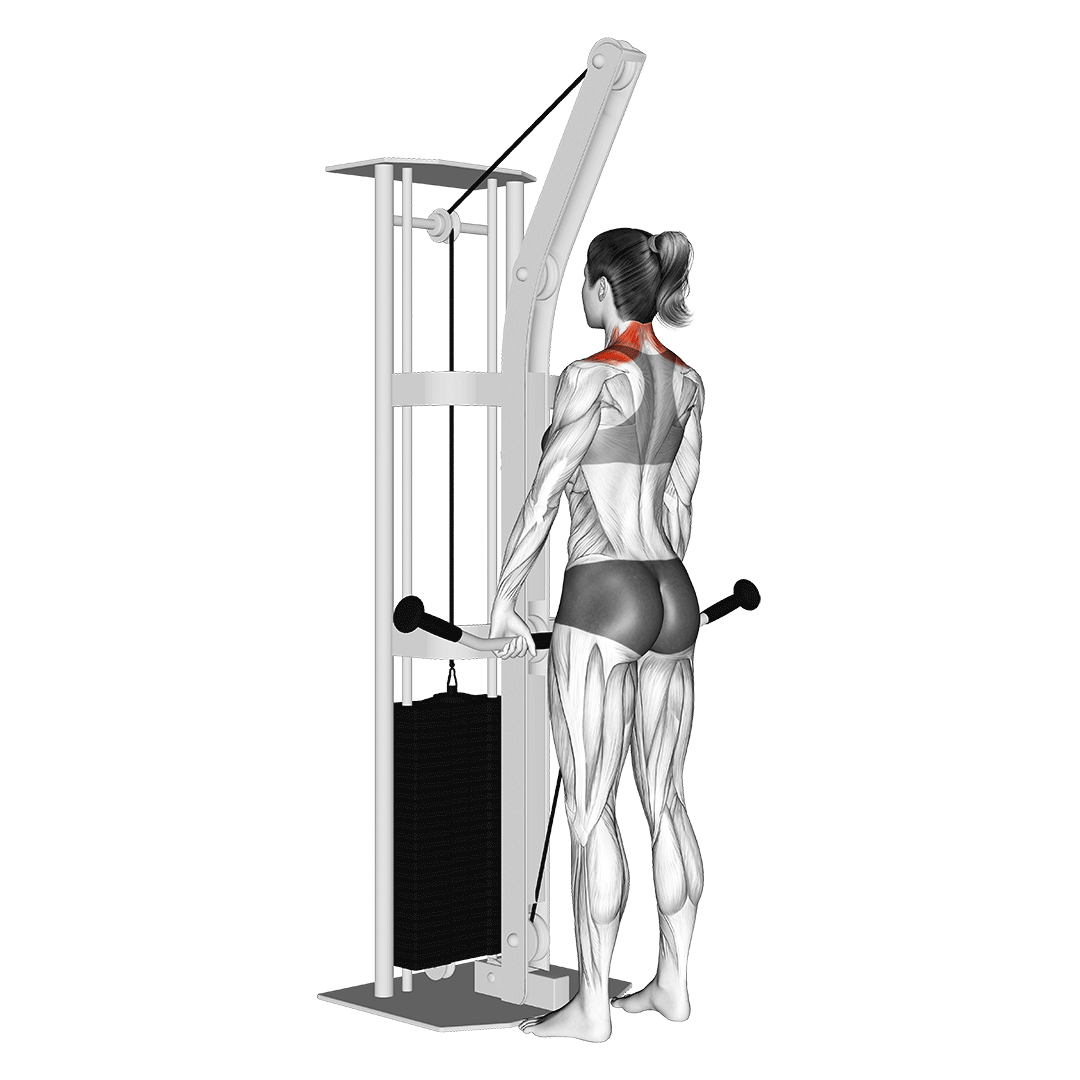
Cable shrugs are a single-joint exercise that isolate the trapezius muscles with a relatively short range of motion. As far as cable machine exercises go, they’re quite simplistic - but nonetheless very effective at what they do.
Because an immediately vertical angle of resistance is difficult to achieve with a cable machine, the cable shrug does differ from its free weight counterpart. Of course, this is relatively minor in the grand scheme of the exercise, and primarily revolves around the direction in which the lifter needs to shrug their shoulders.
Muscles Worked
Cable shrugs solely target the trapezius - in particular, the upper section around the neck and shoulders.
Benefits as a Cable Back Exercise
The main benefit of the cable shrug is front and center; it isolates the trapezius. Being a cable machine exercise, this allows for unparalleled training volume and hypertrophy to be achieved, especially in tandem with exercises of a similar nature.
How-to:
To perform a repetition of the cable shrug, the lifter must attach a pair of rope handles (or a bar attachment) to the cable, setting the pulley as low as possible.
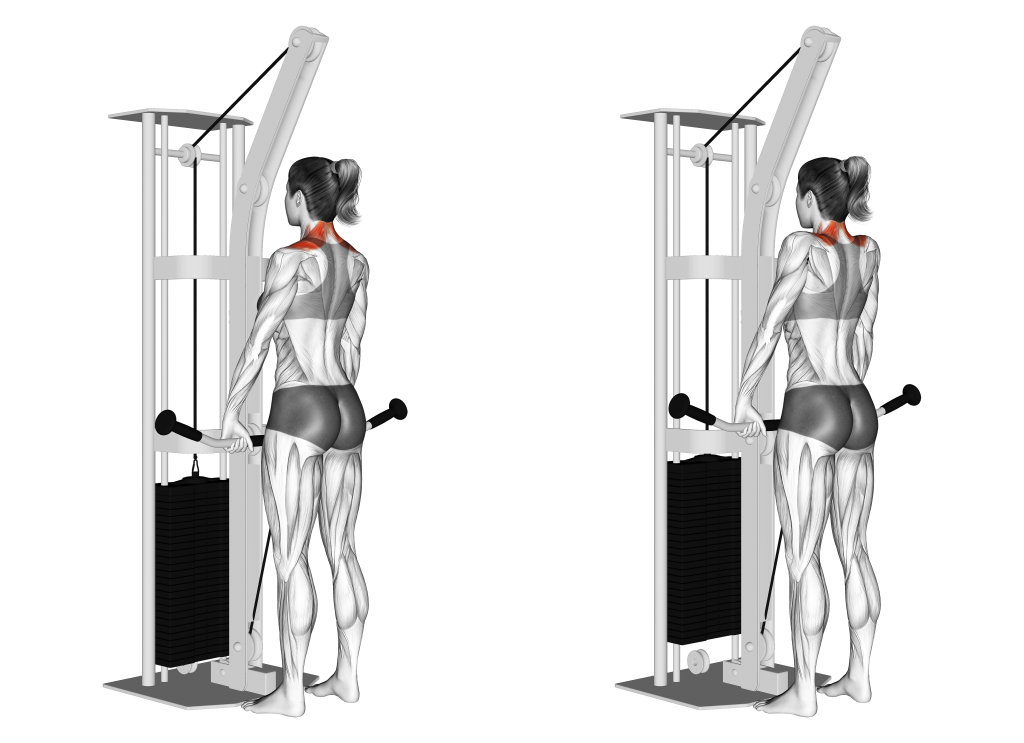
Gripping the handle in both hands, the lifter will first ensure their chest is upright and their shoulders neutral before beginning the exercise.
To do so, they will slowly draw their scapula backwards as they shrug their shoulders both upwards and backwards. The arms should remain straight through this movement, with all the force coming from the upper back.
Once the shoulders are raised as high as the lifter can manage, they will lower them back down to complete the repetition.
4. Cable High Pulls
As one can guess from its name, cable high pulls are a standard horizontal pull performed with the lifter raising the handle up to chest height.
They are also occasionally referred to as cable upright rows, of which are the same within the context of cable exercises. In terms of free weight exercises however, the upright row and high pull are not the same exercise, and the latter is performed as a method of power training.
Unlike barbell high pulls, the cable high pull allows for quite a number of different grip techniques to be used, and is the perfect alternative for individuals worried about injuring their shoulders, as it involves less usage of lower body power.
Of course, it goes without saying that any variation of the high pull must be performed with proper mobility and technical familiarity. It is not quite suitable for novices or the previously injured.
Muscles Worked
The cable high pull will work the deltoids, trapezius, biceps brachii, brachialis and the supraspinatus.
Benefits as a Cable Back Exercise
Cable high pulls are a readily available alternative to the barbell high pull, where they can be used to greatly reduce any risk of injury that may be present. In addition, they are particularly effective for targeting the upper back in a manner that also builds the entirety of the deltoids as well.
How-to:
To perform a repetition of the cable high pull, the lifter will set the machine’s pulley above head-height and affix a rope to the end of the cable.
Gripping both ends of the rope and stepping back for greater tension in the cable, the lifter will begin by drawing their elbows both out to the sides and backwards, retracting the shoulder blades as they do so.
As the upper arms become parallel with the shoulders, the lifter will pause for a moment before allowing the resistance to slowly pull their arms forwards - thereby completing the repetition.
Throughout the exercise, the chest must remain upright and the torso angled vertically or slightly backwards. Furthermore, it is best to avoid pulling with the elbows above the shoulders so as to reduce the risk of impingement.
5. Cable Lat Pushdowns
An exercise commonly confused with the triceps cable pushdown or lat pulldown - the cable lat pushdown is meant to elicit growth in an entirely different part of the body, despite their similarities in movement and name.
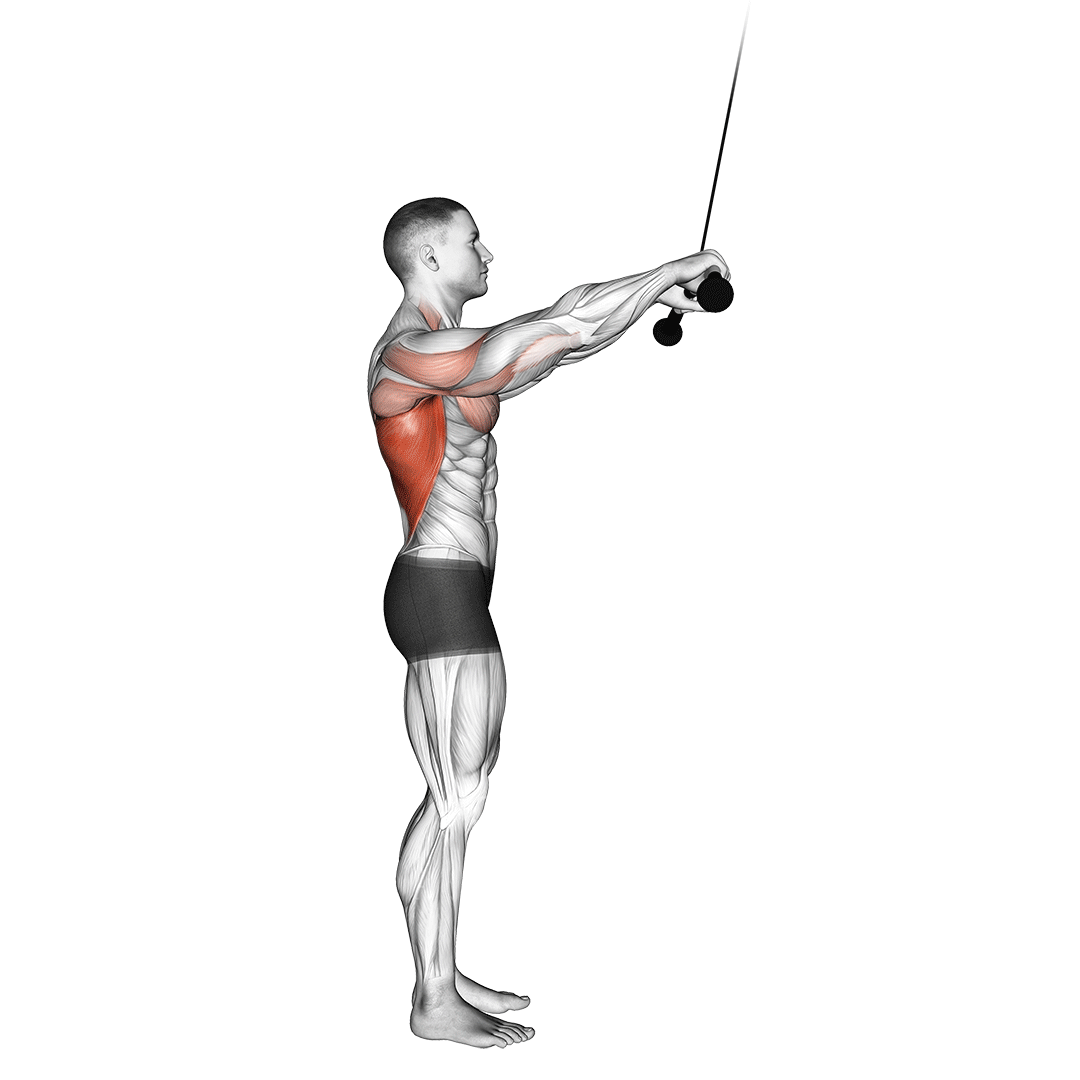
Cable lat pushdowns are a sweeping compound exercise used to target the muscles of the back and (to a lesser extent) those of the chest.
Because of this two-sided muscular recruitment set, the lat pushdown can often be difficult to program outside of a full-body workout. As such, it is more often used as an accessory exercise in back workouts, and rarely as the primary compound exercise.
As a side note - the cable lat pushdown is also occasionally called the “straight arm pushdown” so as to differentiate it from the triceps pushdown or the lat pulldown.
Muscles Worked
Cable lat pushdowns will work the latissimus dorsi, the pectorals, the posterior deltoid head, the trapezius, and the rhomboids. Depending on the attachment and grip width used, the triceps may also play a secondary role.
Benefits as a Cable Back Exercise
The main benefit to the cable lat pushdown is its unique movement pattern - of which allows lifters to target their back from an angle that other exercises will not. This is excellent for building the much-coveted “v-taper” or the appearance of width in the upper back.
How-to:
To perform a cable lat pushdown, the cable pulley should be set above the lifter’s head, with a straight bar or EZ bar attachment affixed to the cable.
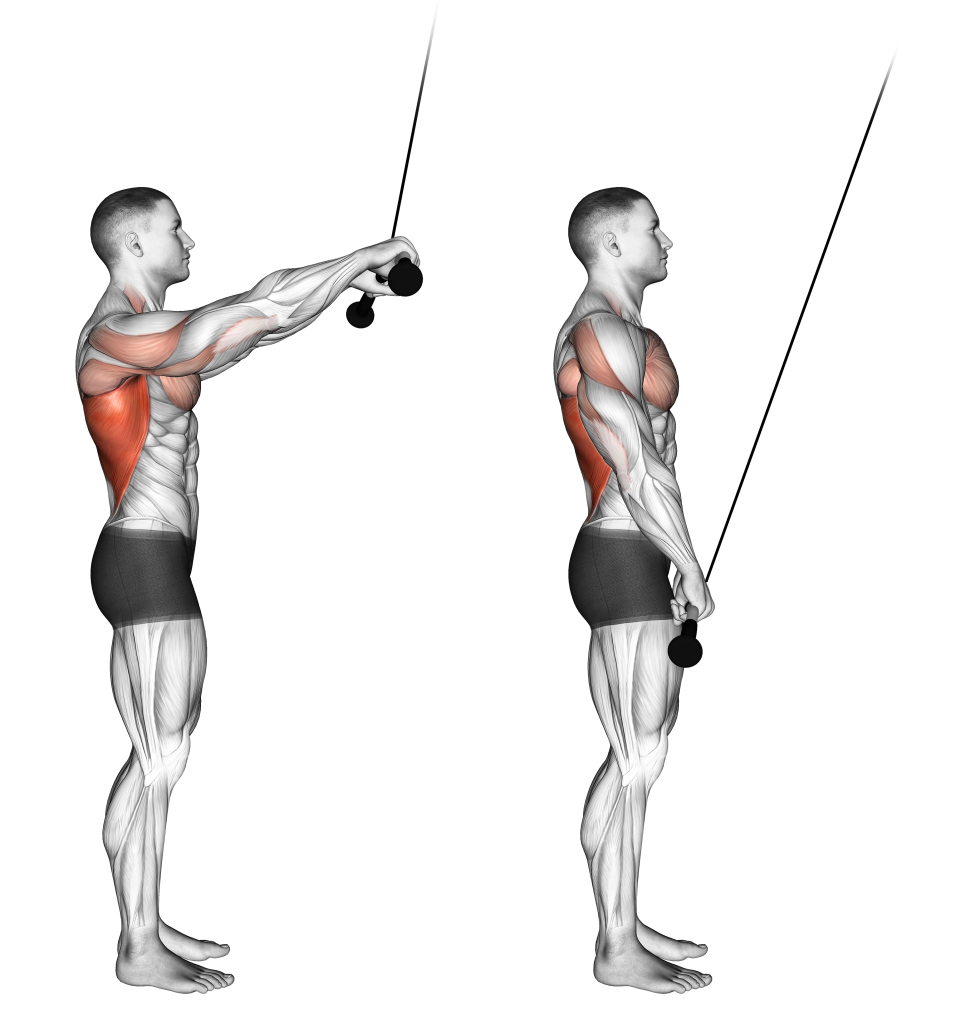
Gripping the handle in a double overhand grip, the lifter will bend at the hips and contract their core so as to better target the lats .
Now appropriately positioned, the repetition begins with the lifter pulling the bar towards their hips - keeping the arms straight and deriving much of the force from their lats alone. Rather than attempting to pull the bar straight down, it can be helpful to imagine pulling the bar in a curved angle instead.
Once the bar is as low as the lifter can manage (generally around the navel), they will slowly reverse the motion and raise the bar back upwards. From this point, the repetition is complete.
6. Cable Face Pulls
One would be mistaken to forget the cable face pull in an article about cable back exercises.
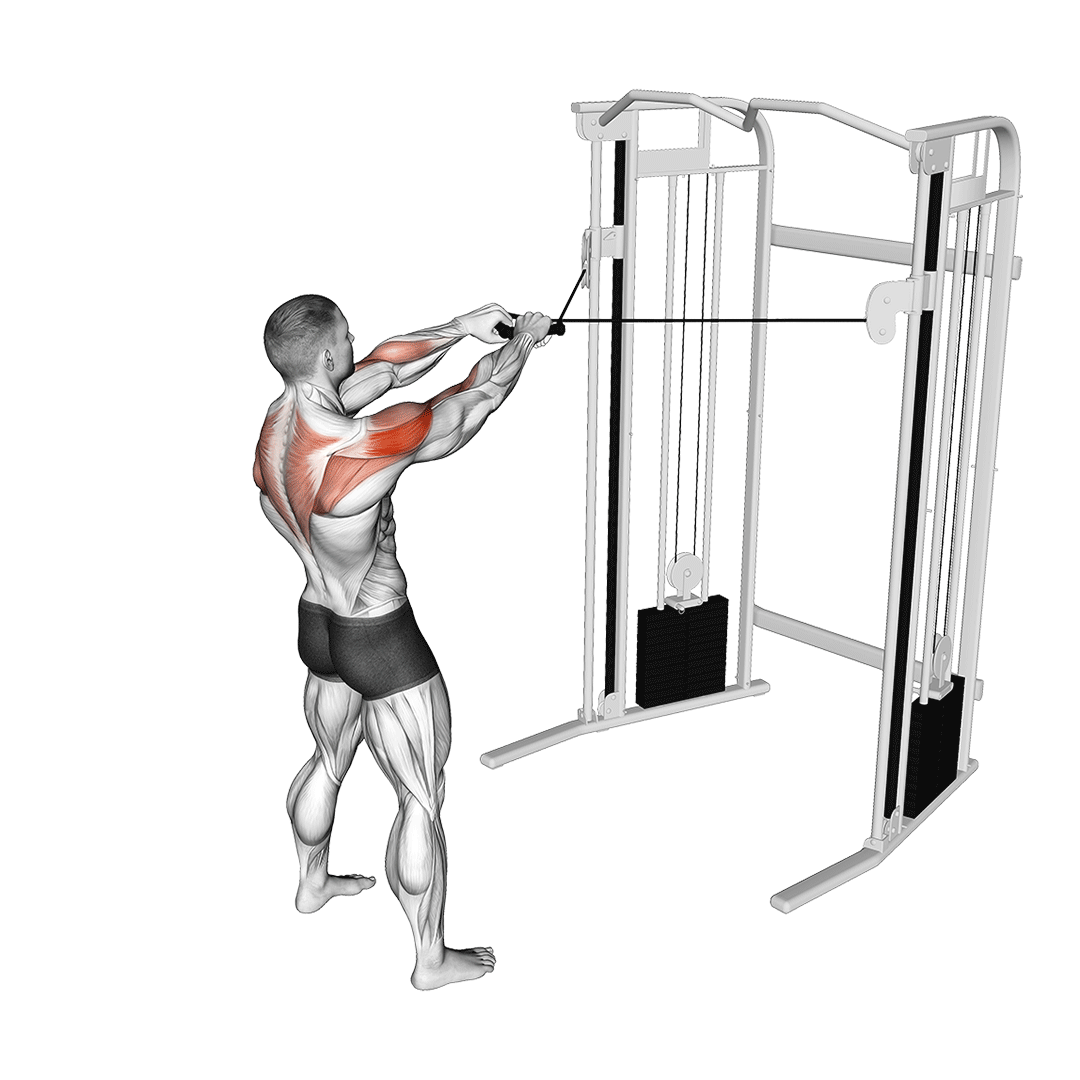
The face pull is a compound horizontal pulling movement meant to target the deltoids, upper back and the muscles of the rotator cuff in a low-impact fashion.
It is used for both resistance training and as a rehabilitation tool, where it often acts as a supporting exercise for strengthening the shoulder girdle and other nearby structures.
Muscles Worked
Cable face pulls primarily target the posterior deltoid head, but will also work the trapezius, rhomboids and the rotator cuff.
Benefits as a Cable Back Exercise
The face pull both builds upper back muscle mass and strength, as well as corrects issues related to poor upper back function - such as poor posture, limited shoulder mobility or weakened rotator cuff stability.
How-to:
To perform a repetition of the cable face pull, the pulley will need to be set at approximately face height, a rope attached to the end.
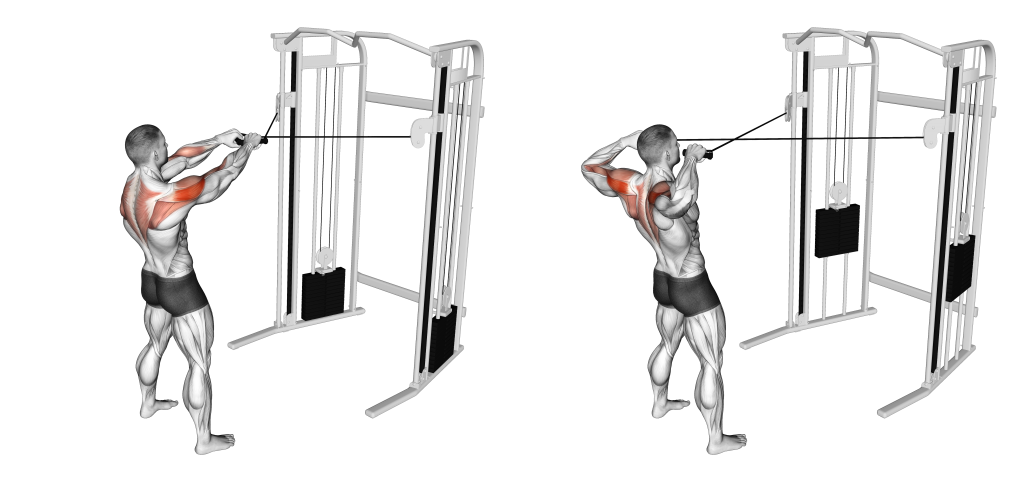
Gripping both ends of the rope, the lifter will face their head forwards and ensure their chest is upright prior to beginning the exercise.
Once positioned correctly, they will draw their elbows backwards and out to the sides, pulling the rope towards their ears as they retract their scapula alongside their elbows.
When the upper arms are parallel to the shoulders and the ends of the rope near the sides of the head, the repetition is considered complete.
Sample Cable Back Workout
The following is a basic cable back workout meant to target all the muscles of the back for general growth. It may be performed on its own, or integrated into an already existing workout plan.
Cable Row - 3 Sets X 8 Repetitions
Lat Pulldown OR Lat Pushdowns - 3 Sets X 12 Repetitions
Cable Shrugs OR Face Pulls - 2 Sets X 12-16 Repetitions
1-2 Accessory Biceps and Lower Back Exercises
Frequently Asked Questions (FAQ)
What is the Best Row Exercise for the Back?
The “best” row exercise for the back will depend on your current training needs. That being said, a good place to start is the Pendlay row, of which works the back through a full range of motion.
Why are Cable Exercises Easier?
Cable exercises are easier because they are self-stabilizing. This means that the body needs to work less to stabilize the movement, allowing for more energy to be diverted towards mobilizer muscles.
How "Good" are Cable Back Exercises?
The cable machine excels when it comes to back exercises. Its unique features allow for exercises to be performed that would otherwise be impossible with free weights or calisthenics.
If you’re looking for a good starting point with cable back exercises, try out the cable row or the lat pulldown.
A Few Reminders
In this article, we’ve listed the most effective back exercises done with a cable machine. Including one or two into your workouts will undoubtedly take your back development to the next level.
Of course, remember to perform each exercise with proper form in mind, and to ensure you are structuring your training program correctly.
References
1. Groscup, David. “Successful Bodybuilding with Machines”. N.p.: CreateSpace Independent Publishing Platform, 2014.ISBN: 9781496039231, 1496039238
2. Lorenzetti, Silvio, Romain Dayer, Michael Plüss, and Renate List. 2017. "Pulling Exercises for Strength Training and Rehabilitation: Movements and Loading Conditions" Journal of Functional Morphology and Kinesiology 2, no. 3: 33. https://doi.org/10.3390/jfmk2030033
